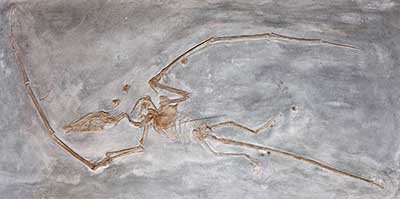Campylognathoides
| Quick Facts | |
|---|---|
| Name Meaning: | Curved Jaw |
| Distribution: | Germany |
| Time Period: | Early Jurassic, 195-165 Ma |
| Diet: | Carnivore |
| Linnaean Classification | |
| Kingdom: | Animalia |
| Phylum: | Chordata |
| Class: | Sauropsida |
| Order: | Pterosauria |
| Suborder: | Rhamphorhynchoidea |
| Family: | Campylognathoididae |
| Genus: | Campylognathoides |

History
The first discovery of the Campylognathoides was of a few bone fragments coming from the reptile's wings. This discovery was made in 1858 in Germany. It was first named in 1864 as the Campylognathus which means "bent jaw." Several years later, in 1893 a better preserved specimen was found. Another specimen found in 1897 was donated six years later to the Pittsburgh Museum of Natural History. It wasn't until 1928 that paleontologist Embrik Strand realized that the name of Campylognathus was already taken and he renamed the genus to Campylognathoides.Description
The Campylognathoides had a short and narrow snout with large eyes set low in the skull. It's teeth were also short and not fang-like. However, the teeth were sharp and excellent for piercing. Because of this it was most-likely a predator and probably preyed on small animals or fish. It had a short tail for balance and short legs. Its feet were also short. Its large eyes and their cranial positioning suggest that the Campylognathoides had acute eyesight and was possibly nocturnal.
ScienceViews Writer: Jason Hamilton.
Copyright © 2005-2010 Calvin & Rosanna Hamilton. All rights reserved.